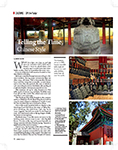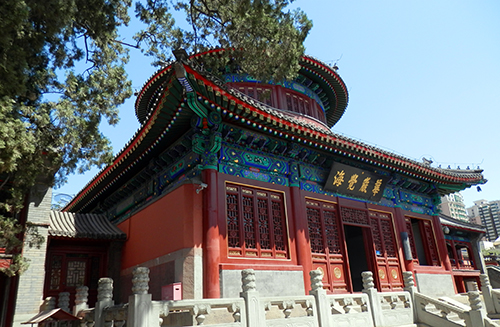Telling the time, Chinese style |
 |
<<Click to see original |
What do a tiger, rat, dog, ox and pig, together with a bell and a drum share in common? I have to admit that a few months ago I would have had absolutely no idea, though I am somewhat the wiser now.
I have come to an ancient bell museum located in the Haidian District of Beijing.
Built in 1733, the Dazhong (giant bell) Si (temple) – 大钟寺 – was where emperors presided over rituals praying for rain. It’s the only one of its kind in China.
Bells are considered auspicious in the Chinese tradition; and during major ceremonies, they are often rung 108 times. According to the Chinese lunar calendar, there are 12 months, 24 solar terms and 72 hou (5 days in a hou), which adds up to the number 108 in all. According to some Buddhists, people also have 108 worries which will be removed by the sound of a bell.
The museum, which was set up in 1985, has over 800 bells, made of bronze, iron and jade. The oldest ones were cast over 1,000 years ago and there are exhibits from all over the world.
One of the most beautiful bells on display is the Qianlong Court Bell from the reign of Emperor Qianlong who ruled from 1736-1795. As its name suggests, the bell was made for the imperial court. It has 22 flying dragon motifs despite having no inscriptions.
At the end furthest away from the main entrance is the building that most visitors come to see. This is known as the Big Bell Tower, and is circular in shape at the top and square below according to the Chinese saying that 'the sky is circular and the earth is square'.

Made in 1403, the first year of Emperor Yong-le, the bell inside was one of the three major projects that he commanded after re-establishing Beijing as the capital. (The other two were the Forbidden City and the Temple of Heaven.) The Great Bell of Yong-le weighs 46.5 tons, is 6.75 metres high, and is struck at the beginning of each Chinese New Year as well as the Spring Festival and other major celebrations. According to the Chinese Academy of Sciences, its loud and clear sound reaches up to 120 decibels and can be heard 50 kilometres away in the depth of the night.
There’s no doubt about it; Chinese bell culture has a very long history. There are basically two sorts of Chinese bell - a Zhong and a Ling. Zhongs produce sound when struck from the outside with a hammer; Lings, on the other hand, have their clappers inside.
Buddhism and Taoism both played a major role in the history of Chinese bells. As long ago as the Sui and Tang dynasties, wherever there was a temple, you could almost guarantee to find bells. However, with the coming of the Song, Liao, Jin and Yuan dynasties, the casting of bells went into a decline, although a great amount of iron bells appeared in this period; but with the advent of the Ming dynasty, the casting of Buddhist and Taoist bells reached ascendancy once again and many large bells appeared during this period.
Apart from their religious significance, bells also played an important part in the daily lives of China’s citizenry. Telling the time by bell and drum played an important role in people’s lives when there was no other means to keep track of the time. As a result, bell and drum towers were widely constructed in almost every city throughout the country. Unlike in other cities, Beijing’s are unique, in that they were placed fore-and-aft, not in the traditional way of standing right-and-left of each other.
The Bell and Drum towers were the very essence of Chinese chronology during the Yuan, Ming and Qing dynasties and it was only when Pu Yi, the last emperor of China, was forced to leave the Forbidden City that western-style clockwork was made the official means of time-keeping.
As early as in the Han Dynasty (206 BC-220), there was 'a morning bell and a dusk drum'. In fact, "The morning bell and dusk drum" is a Chinese idiom, and during ancient times local officials would open the city gates at the toll of the bell early in the morning and close them with the strike of the drum in the evening.
Whereas most people are aware that the Chinese zodiac is based around 12 animals, fewer know that five of those beasts represented time periods in the night. The method of sounding the drum was to beat it quickly for 18 times and then slowly for another 18 times. Altogether there were three rounds like this, making 108 strikes.
Of course, you couldn’t ask your average drummer to work out the time all by himself; so drum towers were also equipped with clepsydras , or water clocks, dating back to the Song Dynasty. A large bronze gong would typically be linked to the water clocks through a series of mechanical devices and sounded each quarter of an hour. When the system of telling time with incense coils, which burned for hours were introduced, the clepsydras fell into disuse.
The Drum towers’ drums were used to keep time at night, while the Bell Towers’ bells kept time during the day. In the Qing Dynasty, the hours were marked at night starting at 7pm, when the drums were sounded 13 times, a procedure that was known as "setting the watch." The night was split into five time segments called Gengs which were equivalent to two hours. Each was named after animals in the Chinese zodiac. The first Geng came at dusk, and was called Xu Shi, or Dog Hour. The second Geng, to mark when people went to sleep, was called Hai Shi or Pig Hour, and it ran from 9pm to 11pm. Zi Shi, or Rat Hour, signalled the middle of the night (11pm to 1am). The fourth Geng was called Chou Shi, or Ox Hour (1am to 3am) and the fifth Geng was Tiger Hour, or Yin Shi, and it ran from 3am to 5am.
The first and last of these Gengs were announced with the beating of drums followed by the striking of the bell; the gate of the city was closed and traffic was stopped as the sound of the first bell rang out each night.
